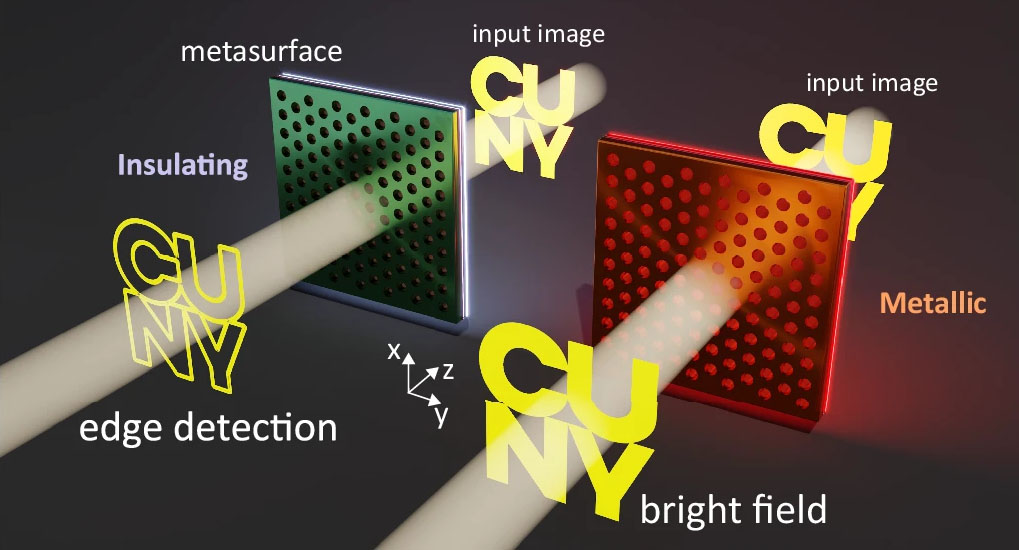| May 28, 2024 |
New metasurface-based edge detecting filter for remote sensing transforms crop monitoring
(Nanowerk News) New work by researchers from the ARC Centre of Excellence for Transformative Meta-Optical Systems (TMOS) and City University of New York (CUNY) published in Nature Communications ("Reconfigurable image processing metasurfaces with phase-change materials") realises a new, tuneable edge-detecting filter for flat-optic imaging systems that can switch between an image of an object’s outline and a detailed infrared image.
|
|
The development of compact lightweight analogue edge detecting image processors is of particular interest for remote sensing applications such as environmental monitoring and surveillance, due to its potential to minimise drone size, extend deployment times, and reduce operating costs. This new research is big step towards realising this device, with the added functionality of standard infrared imaging.
|
|
This could result in cheaper groceries as farmers are better able precisely pinpoint which crops require irrigation, fertilization and pest control instead of taking a blanket approach to crop management. It could also assist with efforts to protect endangered species as edge detection systems can provide valuable data about habitat types and boundaries with ecosystems. This data is used for habitat restoration and protection but is currently costly to collect.
|
|
Edge detection is an image processing tool that extracts the outline of an object, helping to distinguish objects from their backgrounds. Currently, it’s a digital process that occurs after an image is captured, and requires bulky processors and traditional imaging systems. This form of digital edge detection creates lots of data that needs to be processed, stored, and transmitted.
|
 |
| Schematic of the proposed working principle. The same metasurface performs either edge-detection (left) or conventional bright field imaging (right) depending on whether its temperature is lower or higher, respectively, than the transition temperature of a thin layer of vanadium dioxide (VO2) embedded inside the metasurface. (Image: Nature Communications)
|
|
The analogue image filter developed by TMOS researchers and their partners reduces the subject to its outlines prior to capturing the image, drastically reducing the amount of data produced. It can also switch to an unfiltered, detailed infrared image when required, which is a novel development and could allow farmers to collect more information when the remote sensor identifies areas of potential pest infestations.
|
|
The filter is only nanometres thick, with a thin layer of the phase change material vanadium dioxide (VO2) embedded within a thicker silicon metasurface. When the temperature of the filter is changed, the VO2 transitions from an insulating state to a metallic one, and the processed image shifts from a filtered outline to an unfiltered infrared image.
|
|
Meta-optics (also known as flat optics and nanophotonics) is a new field that is miniaturising optical technology using by replacing traditional lenses with metasurfaces. The filter can be combined with a metalens to greatly reduce the size of imaging systems, making it ideal for use on drones, satellites and other applications that require low size, weight and power requirements.
|
|
Lead author Michele Cotrufo says, “While a few recent demonstrations have achieved analogue edge detection using metasurfaces, most of the devices demonstrated so far are static. Their functionality is fixed in time and cannot be dynamically altered or controlled. Yet, the ability to dynamically reconfigure processing operations is key for metasurfaces to be able to compete with digital image processing systems. This is what we have developed.”
|
|
Importantly, while offering the highly sought-after reconfigurability, the metasurface matched the performance of its static counterparts in terms of the numerical aperture, efficiency, isotropy and polarization independence.
|
|
TMOS Partner Investigator Andrea Alu says, “We used a VO2 layer and local heating element as a proof of concept. Now, there’s the potential to expand the research to include non-volatile phase change materials, which don’t require heating, or to integrate it with an external pump laser for optically-induced heating. The latter scenario may open interesting avenues for all-optically reconfigurable nonlinear analogue computation.”
|
|
The prototype was fabricated by TMOS Chief Investigator Madhu Bhaskaran and her team at RMIT University. Bhaskaran says, “Phase change materials such as vanadium dioxide add a fantastic tuning capability to render devices "smart". As demonstrated by us, these materials go a long way in futuristic flat optics devices.”
|
|
Co-author Shaban Sulejman from the University of Melbourne says, “What’s exciting about this filter is that the design and materials used make it amenable to massmanufacturing. It also operates at temperatures compatible with standard manufacturing techniques, making it well-placed to integrate with commercially available systems and therefore move from research to real-world usage so rapidly.”
|
|
TMOS Chief Investigator Ann Roberts, also from the University of Melbourne, says, “Meta-optics has the potential to transform countless industries, and is doing so quickly. Traditional optical elements have long been the bottleneck preventing the further miniaturisation of devices. The ability to replace or complement traditional optical elements with thin-film optics breaks through that bottleneck.
|
|
“For industries such as agriculture, this could mean real-time monitoring of environmental conditions, improved images from remote sensing platforms like drone or satellites, and more extensive data collection without the corresponding logistical challenges that usually accompany it.”
|
|
This research is an excellent example of the power of ARC-funded Centres of Excellence. The work was a joint project between TMOS researchers at the University of Melbourne and RMIT University as well as TMOS partner investigator Andrea Alu and his team at City University of New York (CUNY).
|
|
TMOS PhD student Shaban Sulejman visited CUNY during the experimental phase of the research, supported by the Centre’s Partner Exchange Program, which provides awardees $5000 AUD to support student travel to and from partner organisations.
|

